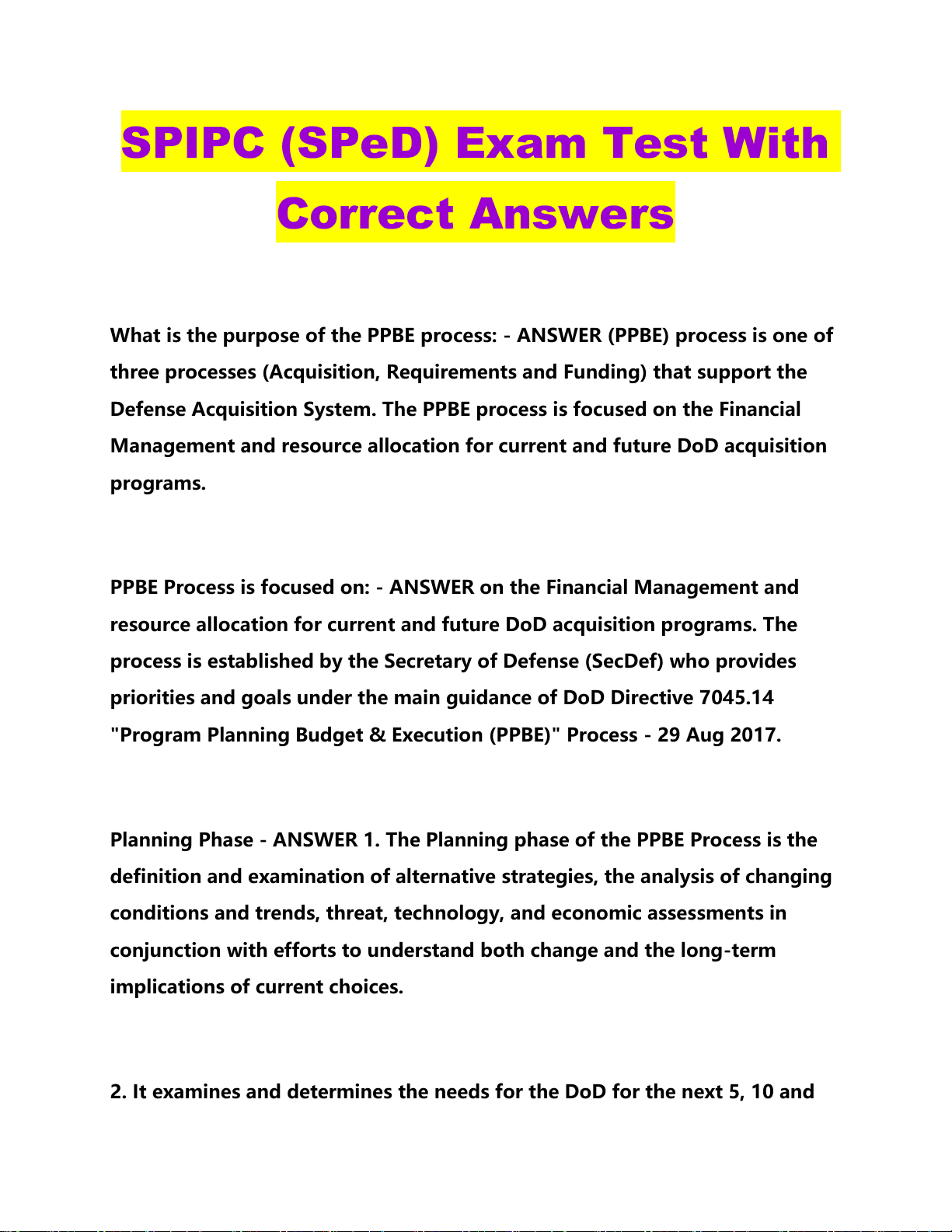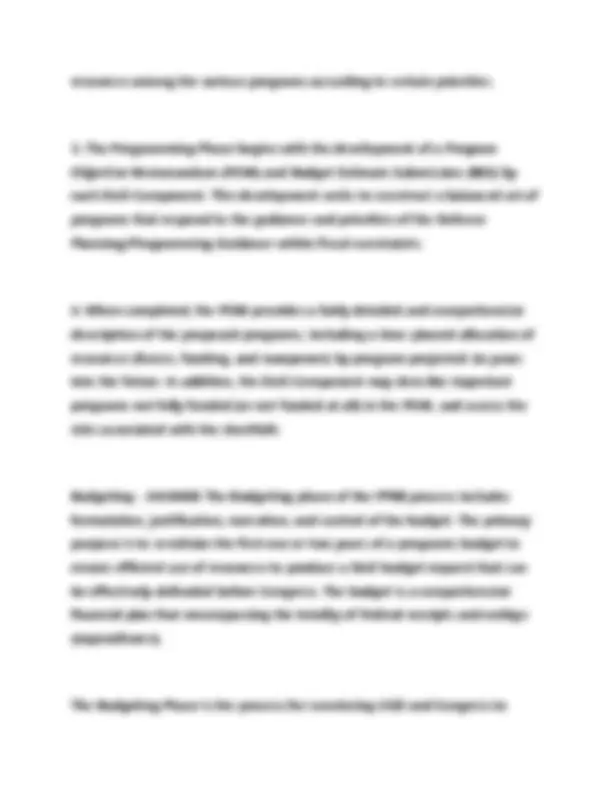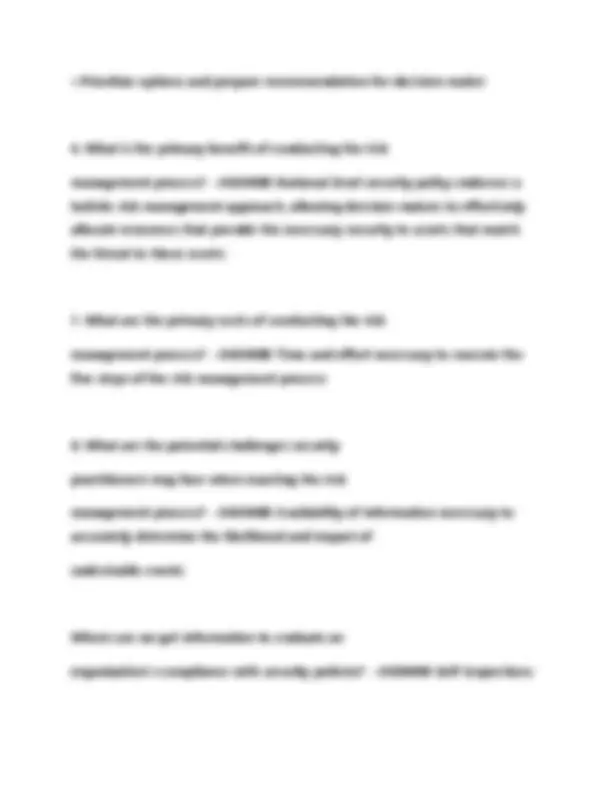








Study with the several resources on Docsity

Earn points by helping other students or get them with a premium plan


Prepare for your exams
Study with the several resources on Docsity

Earn points to download
Earn points by helping other students or get them with a premium plan
Community
Ask the community for help and clear up your study doubts
Discover the best universities in your country according to Docsity users
Free resources
Download our free guides on studying techniques, anxiety management strategies, and thesis advice from Docsity tutors
A detailed explanation of the program planning, budgeting, and execution (ppbe) process within the department of defense. it's structured as a series of questions and answers, covering key phases like planning, programming, budgeting, and execution. the q&a format facilitates understanding of complex defense resource management concepts, making it valuable for students of defense acquisition, public administration, or related fields.
Typology: Exams
1 / 11

This page cannot be seen from the preview
Don't miss anything!







What is the purpose of the PPBE process: - ANSWER (PPBE) process is one of three processes (Acquisition, Requirements and Funding) that support the Defense Acquisition System. The PPBE process is focused on the Financial Management and resource allocation for current and future DoD acquisition programs.
PPBE Process is focused on: - ANSWER on the Financial Management and resource allocation for current and future DoD acquisition programs. The process is established by the Secretary of Defense (SecDef) who provides priorities and goals under the main guidance of DoD Directive 7045. "Program Planning Budget & Execution (PPBE)" Process - 29 Aug 2017.
Planning Phase - ANSWER 1. The Planning phase of the PPBE Process is the definition and examination of alternative strategies, the analysis of changing conditions and trends, threat, technology, and economic assessments in conjunction with efforts to understand both change and the long-term implications of current choices.
20+ years into the future from strategic guidance.
Programming Phase - ANSWER 1. The Programming phase of the PPBE process defines and analyzes alternative force structures, weapon systems, and support systems together with their multi-year resource implications and the evaluation of various tradeoff options.
provide the necessary resources and then balancing the checkbook to ensure the resources are spent in accordance with the law.
The budgeting phase of PPBE occurs concurrently with the programming phase; each DoD Component submits its proposed budget estimate simultaneously with its Program Objective Memorandum (POM). The budget converts the programmatic view into the format of the congressional appropriation structure, along with associated budget justification documents. The budget projects resources only two years into the future, but with considerably more financial details than the POM.
After the hearings, each analyst prepares a decision document (known as a Resource Management Decision (RMD) for the programs and/or appropriations under his or her area of responsibility. The RMD proposes financial adjustments to address any issues or problems identified during the associated budget hearing. The RMDs are staffed for comment and forwarded to the Deputy Secretary of Defense for decisions. These decisions are then reflected in an updated budget submission provided to the OMB. After that, the overall DoD budget is provided as part of the President's Budget request to the Congress. [1]
Execution - ANSWER The Execution phase of the PPBE process is the real world application of the Planning, Programming, Budgeting and Execution process
The execution review occurs simultaneously with program and budget reviews. The execution review provides feedback to the senior leadership concerning the effectiveness of current and prior resource allocations. Over time, metrics are being developed to support the execution review that will measure actual output versus planned performance for defense programs. To the extent performance goals of an existing program are not being met, the execution review may lead to recommendations to adjust resources and/or restructure programs to achieve desired performance goals.
What events must take place before the DoD can execute is program: - ANSWER - The President signs the Authorization and Appropriations bills passed by the Congress
Risk management is a five-step process that provides a framework for collecting and evaluating information to: - ANSWER • Assess assets (identify value of asset and degree of impact if asset is damaged
assessment step of the risk management
process? - ANSWER - Identify existing countermeasures and their level of effectiveness in reducing vulnerabilities
of the risk management process? - ANSWER • Integrate information about the impact of undesirable events (collected during the asset assessment step) and the likelihood of undesirable events (based on information collected during the threat and vulnerability assessment steps) to determine risks to identified assets
management process? - ANSWER National-level security policy endorses a holistic risk management approach, allowing decision makers to effectively allocate resources that provide the necessary security to assets that match the threat to those assets
management process? - ANSWER Time and effort necessary to execute the five steps of the risk management process
practitioners may face when enacting the risk
management process? - ANSWER Availability of information necessary to accurately determine the likelihood and impact of
undesirable events
Where can we get information to evaluate an
organization's compliance with security policies? - ANSWER Self-Inspections
condition by taking an alternated path. It eliminates the source of the risk and replaces it with another solution.
Analyzing and reviewing the proposed system in detail provides insight into the drivers for each technical requirement.
Risk Transfer - ANSWER Risk transfer includes reassigning or delegating responsibility for tasks to mitigate a risk to another entity. This might include transferring the financial responsibility as well. This approach may involve reallocating risk management tasks from one program to another, between government organizations, or across two sides of an interface managed by the same organization. The same risk may be carried (shared) by multiple government organizations. However, programs should recognize transference of risk does not eliminate all responsibility and risks must be monitored for potential consequences. While financial risk may be substantially transferred by certain contractual arrangements or inter-program agreements, the schedule and performance risk cannot be fully transferred because the government needs the product. For example, if a radio is built to be used by multiple platforms but is
modified for use on one platform program, it may be a risk to that program, but it also can be a risk to the radio program office. Development of government-furnished equipment for application to multiple programs typifies this type of risk.
Risk Control - ANSWER The risk control option seeks to actively reduce risk
to an acceptable level. Control generally entails taking action to reduce the likelihood, or the consequence, of a risk to as low as practical in order to minimize potential impacts. Section 2 discussed activities to reduce risk exposure by phase.